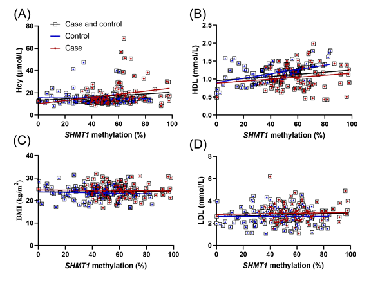The association between serine hydroxymethyl transferase 1 gene hypermethylation and ischemic stroke
DOI:
https://doi.org/10.17305/bjbms.2020.5188Keywords:
Ischemic stroke, DNA methylation, serine hydoxymethyl transferase 1, homocysteine, high-density lipoprotein, sexAbstract
This study aimed to determine the correlation between serine hydroxymethyl transferase 1 (SHMT1) gene methylation and ischemic stroke. A total of 202 age- and sex-matched individuals were included. Quantitative methylation-specific polymerase chain reaction (qMSP-PCR) was used to analyze the DNA methylation level. The plasma homocysteine (Hcy) concentration was much higher in ischemic cases than in controls (p = 0.009), while the high-density lipoprotein (HDL) levels in stroke cases were considerably lower than in controls (p = 0.005). A significantly higher level of SHMT1 methylation was observed in the ischemic strokes (58.82 ± 17.83%) compared to that in the controls (42.59 ± 20.76%, p < 0.001). The SHMT1 methylation level was strongly correlated with HDL concentration in the healthy controls (r = 0.517, p < 0.001), while the high plasma level of Hcy showed strong association with SHMT1 methylation in ischemic strokes (r = 0.346, p < 0.001). Receiver operating characteristic (ROC) analysis of curve indicated that SHMT1 methylation has been an acceptable indicator for ischemic stroke in female patients [all sexes, area under the curve (AUC) = 0.71, p < 0.001; male patients AUC = 0.62, p = 0.032; and female patients AUC = 0.79, p < 0.001] and in all ages (AUC = 0.71, p < 0.001). In our samples, DNA methylation levels of the STHMI gene were significantly correlated with ischemic stroke in Han Chinese. STHMI hypermethylation was significantly associated with the high Hcy concentration in ischemic stroke and had value as a potential indicator for female ischemic stroke.
Citations
Downloads

Downloads
Additional Files
Published
How to Cite
Accepted 2020-11-27
Published 2021-08-01









